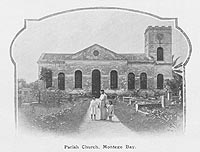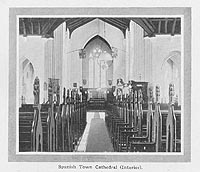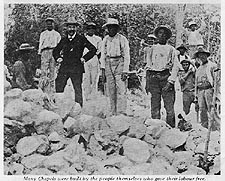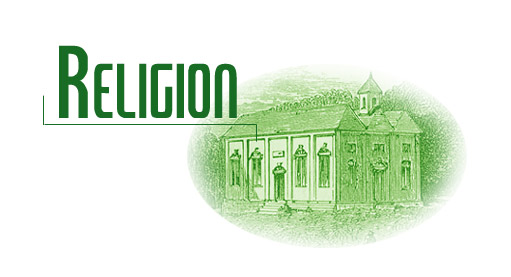
According
to missionaries, before their arrival in Jamaica, heathenism was rampant in both the
white and the black population. There
were many missionary groups, but my research focused on the experiences
of the Baptists, the Moravians and the Wesleyans. There is no consistency in any of their experiences—sometimes
the Jamaican people accepted them warmly, and sometimes they did not.
The missionaries attempted to convert two groups of people to
their version of Christianity: the white elite/slave owners and the
black slaves. An important note
is that the different groups never attempted to work together as Christians
to convert the people of Jamaica, which makes one wonder about their
agenda. And one cannot ignore
the fact that in addition to the many honest missionaries doing what
they thought was right, there were many corrupt and dishonest missionaries. Through the use of primary sources, I intend
to relate the history of their work, their experiences and what they
thought was right.
 Many
of the missionaries came to Jamaica with preconceptions about the nature
of the people whom they were attempting to convert, whether white or
black. A few missionaries took
pity on and understood the situation of the slaves, but many more thought
that the slaves were ignorant beasts incapable of being educated and
“saved.” To the missionaries, the practice of religious
cultures brought from Africa was more than shocking and the use of bones, feathers and
superstitions was sacrilegious. Another
reason that the missionaries considered that the slaves were living
“without hope and without God in the world,” was the fact that there
were no official, legal marriages and that having concubines was acceptable.
Of course, the missionaries’ opinion of the Jamaican whites was not
much better. Evangelists believed that as soon as the whites
left Europe, they “left their profession of Christianity
behind.” The whites were also considered heathens by the missionary
groups as they too were living in concubinage,
not attending church and generally living an unchristian lifestyle.
Many
of the missionaries came to Jamaica with preconceptions about the nature
of the people whom they were attempting to convert, whether white or
black. A few missionaries took
pity on and understood the situation of the slaves, but many more thought
that the slaves were ignorant beasts incapable of being educated and
“saved.” To the missionaries, the practice of religious
cultures brought from Africa was more than shocking and the use of bones, feathers and
superstitions was sacrilegious. Another
reason that the missionaries considered that the slaves were living
“without hope and without God in the world,” was the fact that there
were no official, legal marriages and that having concubines was acceptable.
Of course, the missionaries’ opinion of the Jamaican whites was not
much better. Evangelists believed that as soon as the whites
left Europe, they “left their profession of Christianity
behind.” The whites were also considered heathens by the missionary
groups as they too were living in concubinage,
not attending church and generally living an unchristian lifestyle.
Of
the two groups of people living in Jamaica, the whites were the most  inconsistent
in their reaction to the missionaries. Many whites strongly resisted the acceptance
of the different missionary groups.
One of the reasons is that they did not want their slaves to
be educated because it was easier to oppress them when they were uneducated. Jamaican whites feared that Christianity would
give the enslaved hope and provoke thought, and then once the slaves
started thinking they would become more rebellious. Also they did not want to give their slaves
time off to worship in the evenings and the mornings.
inconsistent
in their reaction to the missionaries. Many whites strongly resisted the acceptance
of the different missionary groups.
One of the reasons is that they did not want their slaves to
be educated because it was easier to oppress them when they were uneducated. Jamaican whites feared that Christianity would
give the enslaved hope and provoke thought, and then once the slaves
started thinking they would become more rebellious. Also they did not want to give their slaves
time off to worship in the evenings and the mornings.
The
whites were sometimes brutal when it came to oppressing the work of
the missionaries. They passed
religiously intolerant laws, forbidding the missionaries from preaching
and giving serious punishments to anyone found preaching.
These laws were later dropped, but they took a toll on the ability
of the missionaries to Christianize the island in the way that they
had wanted. In 1831-1832, after
the rebellion of the “Baptist War,” the whites destroyed and burned
the missionaries' churches. On
other occasions churches were defaced while the police turned their
heads, rarely taking legal action against the criminals.
There were also outbursts of violence towards the preachers themselves.
Dr. Coke, of the Wesleyan missionaries, was attacked in the late
1780's by a mob of white men who didn't like his sermon on Ethiopia becoming Christianized. The whites also sent abusive and slanderous
letters to the newspapers denouncing the missionaries and their work. Many times whites attended sermons for the sole
purpose of rudely interrupting and causing a scene; at times they paid
their slaves to create the disturbances.
[1]
Although
many whites tried to stop the progression of missionary work, some whites
accepted and supported the missionaries.
They opened their homes to the missionaries and their families,
and they donated money to help build meetinghouses, churches and schools. There were slave owners that requested that
the missionaries come to their estate preach to them and their slaves. They would give the slaves time off to hear
the sermons, and in some cases, would insist on and pay for the baptism
of all of their slaves. As generous
and Christian as this may seem, the master and the preacher actually
had a hidden agenda. The master thought that once the slaves were
baptized they would have no interest in actually practicing Christianity,
thus avoiding the issue of education, literacy and critical thinking
for the slaves. This was an intelligent
theory on the part of the master, because many slaves did not go to
sermons once they had been baptized.
[2]
 The
second group of people that the missionaries intended to Christianize
was the black slaves. For the most part the missionaries were well
received by the slaves and their teachings were embraced. Even so, Christianizing the blacks would prove
to be more difficult than Christianizing the whites for several reasons.
Most of the black slaves were not fluent in English and many
were illiterate. This meant that
for the missionaries preaching and sermons were crucial to get their
message across, but the slave owners did not want their slaves to go
to sermons morning and night because that would hinder the production
of their crops. In many cases
a pastor would pick a literate slave to read the Bible and give sermons
in his absence. The problem with that—from the missionaries’
point of view—was that the slaves then began interpreting the Bible
in their own way and mixing Christianity with their own African religion. This displeased the missionaries because upon
their arrival at an estate, they would be bombarded with questions they
thought were ridiculous. One
instance was a group of slaves who insisted that John the Baptist was
the Son of God because he baptized Jesus.
The slaves thought that if Jesus was the son of God that his
name should be Jesus the Baptist. Another
problem for the missionaries was the distance of the parishes from where
the slaves lived, if there was no parish near an estate it was nearly
impossible for a slave to go to a sermon.
There are recorded instances when slaves would walk twenty miles
or more on a Saturday night after working in the fields all day to arrive
at a sermon on Sunday just to have to turn around and walk home.
Many slaves converted to Christianity for the simple reason that
they thought if they were baptized it would protect them from Obeah,
an African religious belief that is based on the casting of spells.
[3]
The
second group of people that the missionaries intended to Christianize
was the black slaves. For the most part the missionaries were well
received by the slaves and their teachings were embraced. Even so, Christianizing the blacks would prove
to be more difficult than Christianizing the whites for several reasons.
Most of the black slaves were not fluent in English and many
were illiterate. This meant that
for the missionaries preaching and sermons were crucial to get their
message across, but the slave owners did not want their slaves to go
to sermons morning and night because that would hinder the production
of their crops. In many cases
a pastor would pick a literate slave to read the Bible and give sermons
in his absence. The problem with that—from the missionaries’
point of view—was that the slaves then began interpreting the Bible
in their own way and mixing Christianity with their own African religion. This displeased the missionaries because upon
their arrival at an estate, they would be bombarded with questions they
thought were ridiculous. One
instance was a group of slaves who insisted that John the Baptist was
the Son of God because he baptized Jesus.
The slaves thought that if Jesus was the son of God that his
name should be Jesus the Baptist. Another
problem for the missionaries was the distance of the parishes from where
the slaves lived, if there was no parish near an estate it was nearly
impossible for a slave to go to a sermon.
There are recorded instances when slaves would walk twenty miles
or more on a Saturday night after working in the fields all day to arrive
at a sermon on Sunday just to have to turn around and walk home.
Many slaves converted to Christianity for the simple reason that
they thought if they were baptized it would protect them from Obeah,
an African religious belief that is based on the casting of spells.
[3]
Some groups of slaves in distant parts
of the island were not violent towards the missionaries, but still did
not accept their teachings. There
were some areas of the island where the slaves had no interest in Christianity
or missionaries. According to
the Baptists, these blacks were heathens and living in sin.
The churches would be nearly empty and the missionaries would
leave due to lack of interest in their sermons.
Although there were many missionaries
that were honest and decent, there were just as many who were not.
Many of the missionaries took advantage of the old and uneducated
slaves. The missionaries bartered
their religious teachings for money and convinced the slaves to buy
religious materials at inflated prices. One a Baptist preacher turned slave children
away from his school because they did not have the 1-pound 'tax' required
to attend. Some pastors made
slaves to pay to be baptized, pay yearly dues to attend church and pay
monthly communion fees. Because
the missionaries took as much money as they could get, they were nicknamed “macaroon hunters” by the slaves.
[4]
Missionaries undertook the task of
Christianizing the people on the island of Jamaica, black and white alike. They were met with opposition by some, acceptance
by others and indifference by the rest. Through the use of the Bible they intended to
civilize the inhabitants of the island and make them moral people. While each group claimed to be wildly successful,
the Christian mission as a whole was highly unorganized and sometimes
dishonest. What this research
has shown is that although they met many obstacles along the way, the
missionaries persisted in their effort to Christianize an entire island
nation. They were somewhat successful in promulgating Christianity and
by the time their missions were through they had converted and baptized
many people.

